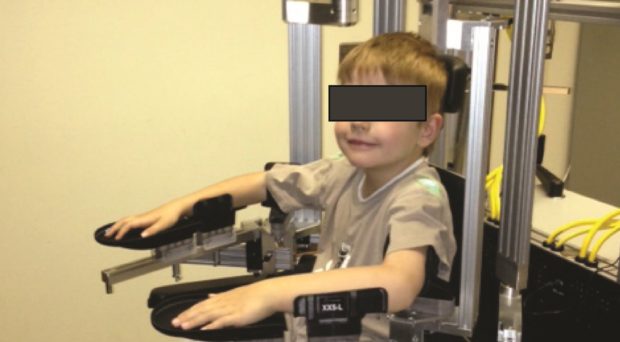
Stroke is one of the world’s leading causes of disability and death. Most of us know someone who has been affected by stroke, and when we think about stroke we often think of a parent, uncle, or grandparent. Many people are surprised to learn that the perinatal period, between 20 weeks of gestation and the first 28 days of life, harbors one of the highest risks for stroke.
Many people are surprised to learn that the perinatal period, between 20 weeks of gestation and the first 28 days of life, harbors one of the highest risks for stroke.
Perinatal ischemic stroke
Perinatal ischemic stroke is an interruption in the blood supply in the infant/newborn brain. These strokes are fairly common, affecting thousands worldwide, and cause life-long disability including cerebral palsy, which is defined by sensory and motor deficits on one side of the body (also known as hemiparesis).
Over the years, new evidence has demonstrated that the “unaffected” limb in adult stroke survivors also shows impairments in performing daily functions. Studies have shown that the “unaffected” upper limb has reduced speed, coordination, and strength compared to healthy individuals.
So why have rehabilitation and research strategies strongly focused on the impairments in the stroke-affected limb? One reason may be that stroke has been primarily thought to be a unilateral problem – one side of the brain and the opposite side of the body are affected. Related to this, deficits in the stroke-affected limb are more pronounced.
However, one of the limitations in understanding movement of the upper limb after stroke is the lack of objective and sensitive measures – clinicians are limited by the clinical tools they have available. If clinicians are unable to accurately assess smaller, more subtle changes in function, how are they to identify deficits in a less-affected limb?
If clinicians are unable to accurately assess smaller, more subtle changes in function, how are they to identify deficits in a less-affected limb?
Using a new exoskeleton robot called the KINARM, we measured reaching movements in healthy children and those with hemiparetic cerebral palsy secondary to perinatal stroke between the ages of 6 and 19. With their arms supported by the robotic exoskeleton but the freedom to move on their own, our participants tried to make straight movements between targets as fast as they could. From these movements we recorded information about the speed, length, angular deviation, and time to complete each movement. Our previous work using the KINARM robot has demonstrated the efficacy, tolerability, and safety of using this device in the pediatric population.
The study
In the present study, we found movement deficits in both the stroke-affected and “unaffected” arms of children with perinatal stroke. These included slower movement times and slower speeds, and were more prominent in the arterial stroke group in which the stroke affected a larger area of the brain compared to a venous stroke group in which the strokes were acquired earlier in life (in utero, or while in mother’s womb) and are smaller in nature, sparing important cortical structures and allowing time for potential “rewiring” to occur.
Overall, we found that some children with perinatal ischemic stroke demonstrated significant deficits when completing reaching movements with both their stroke-affected and less-affected arms. Although movement deficits in the less-affected arm may be more subtle and less severe than those observed in the stroke-affected limb, impairment in the “unaffected” arm may be detrimental in children and adolescents who rely on that arm as their primary limb to complete daily actions independently, interact with their environment, and participate in school activities.
More research is needed to better understand whether treating the motor impairments in the less-affected arm could improve function in children with hemiparetic cerebral palsy.
We have added to the growing body of evidence that the “unaffected” upper limb is abnormal in many cases after perinatal stroke and represents a new target for treatment. More research is needed to better understand whether treating the motor impairments in the less-affected arm could improve function in children with hemiparetic cerebral palsy.
This study would not have been possible without the support and voluntary participation of our study subjects and their families. The Calgary Pediatric Stroke Program (Canada) has enrolled over 500 children with perinatal stroke since 2007, providing innovative treatment and support to children and their families while also expanding what is currently understood about perinatal stroke and rehabilitation.
Moving forward, we will be investigating the relationship between motor and sensory deficits measured by the KINARM robot in this same population of children and adolescents in the hopes of improving the overall outcome in children with perinatal stroke.
Comments